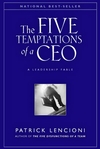|
|
||
|
|
THE FIVE DYSFUNCTIONS OF
A TEAM A Leadership Fable Patrick Lencioni Jossey-Bass, 2002, 229 pp. |
|
|
A new CEO inherits a talented but dysfunctional executive
team in this easy-to-read fable. The
story is built around five dysfunctions that build upon one another to
inhibit teamwork-oriented toward results.
All you need is the pyramid illustration with explanation. But the story adds “body” to the concepts. Teamwork is a major competitive advantage because it is
both powerful and rare. But teams are
inherently dysfunctional because they consist of people. (Intro) Trust is the foundation of teamwork – trusting people to
admit their mistakes, weaknesses and concerns and trusting there will no
reprisal for doing so. (44) Trust can only be built by overcoming the need for
invulnerability. (63) Team members must focus on group results rather than
individual recognition. They all
pursue common goals with a common set of measurements and use these
measurements to make collective decisions daily. Everyone is responsible for all corporate goals. (82-3)
“Politics is when people choose their words and actions
based on how they want others to react rather than based on what they really
think.” (88) Open, constructive conflict doesn’t happen when people
don’t trust each other. Instead, an
artificial harmony – which breeds deeper conflict – is preserved. (91) Conflict is important in getting everyone to buy into a
plan or decision. “When people don’t
unload their opinions and feel like they’ve been listened to, they won’t
really get on board.” People don’t
always have to get their way, but they need to know they were heard and have
their input considered and responded to.
(94-5) There must be productive conflict during meetings, not
focused on individuals but conflict over work issues. (101) The leader pushes conflict, drives for clear commitments,
and expects individuals to hold one another accountable. (113) It’s not easy to hold people accountable – some are so helpful you don’t feel like
criticizing them; some are defensive; some are intimidating. We tend to avoid the discomfort of
difficult conversations. (148, 212) Conflict is always uncomfortable. But you have to do it anyway. (175) Building a cohesive team is difficult but not
complicated. It’s important to keep
it simple. (185) The model: Absence
of trust à fear of
conflict à lack of
commitment à
avoidance of accountability à
inattention to results. When people are unwilling to be vulnerable, open with one
another, they don’t trust one another.
This sets the stage for guarded comments instead of passionate
debate. Without having been truly
heard, team members retain their skepticism and do not fully commit to
decisions. Because they don’t own the
goal, they avoid accountability.
While individuals pursue their own needs and agendas, collective goals
go without attention. (188) Alternatively, effective teams trust each other, struggle
openly with ideas, commit to plans, hold each other accountable for delivery,
and focus on collective results.
(189-90) A team assessment profile is included in pp. 191-94. Teamwork is all but impossible without trust, the
confidence that peers’ intentions are good and they are open about
weaknesses, errors, and needs.
(195-96) Building trust requires “shared experiences over
time.” (197) “The most important action that a leader must take to
encourage the building of trust on a team is to demonstrate vulnerability
first.” (201) Great relationships require productive tensions to
grow. Teams that avoid ideological
conflict often encourage dangerous tension.
(202-3) Commitment is a function of clarity and buy-in. (207) One of the best tools for ensuring commitment is honoring
clear deadlines with discipline. Peer
pressure is the most effective means of maintaining high standards. (210, 213) Assure attention to results by clarifying desired results and rewarding only behaviors that contribute to those results. (218) |
||
